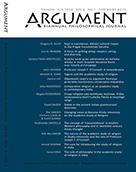Changing views at Banaras Hindu University on the Academic Study of Religion: A first report from an on‑going research project
Changing views at Banaras Hindu University on the Academic Study of Religion: A first report from an on‑going research project
Author(s): Åke Sander, Clemens Cavallin, Sushil KumarSubject(s): Higher Education , Sociology of Religion
Published by: Wydawnictwo Uniwersytetu Komisji Edukacji Narodowej w Krakowie
Keywords: secularity; higher education; sociology of religion; Banaras Hindu University; religion vs. dharma;
Summary/Abstract: Given India’s vibrant religious landscape, there is a somewhat surprising paucity of departments, centres or even programs for the academic study of religion. This article discusses this issue based on the preliminary results of an interview study conducted at Banaras Hindu University (BHU), Varanasi, India, in 2014 and 2015. Its focus is on the views of university teachers and researchers concerning the place, role and function of religion and religious studies at BHU. Twenty eight semi structured interviews were conducted. In the course of their analysis, six themes emerged: 1) the place and role of religion in society; 2) religion as ‘religiosity/spirituality’ or sanatana dharma vs. political ideology/communitarianism; 3) religion vs. dharma; 4) secularization; 5) religion in education in general; and, 6) religion in the education at BHU. The informants agreed on the increasing importance of religion in India, and most of them viewed the meaning of secularization as being ‘equal respect for all religions’. Moreover, a majority distinguished between ‘religion’, in the Western sense, and the Indian conception of dharma, considering it regrettable that the latter, described as the common ground of all reli gions, is not taught more extensively at BHU. They also considered the original ideal of BHU’s founder, Madan Mohan Malaviya, to be of significant importance. That ideal involved not only teaching students the knowledge and skill sets found in a standard modern university, but also equipping them with a value based education, grounded upon sanatana dharma. As our project progresses, further understanding of this turn toward dharma education is something we intend to pursue through the lens of multiple modernities, developed by Marian Burchardt et al. as multiple secularities.
Journal: ARGUMENT: Biannual Philosophical Journal
- Issue Year: VI/2016
- Issue No: 1
- Page Range: 107-142
- Page Count: 36
- Language: English

